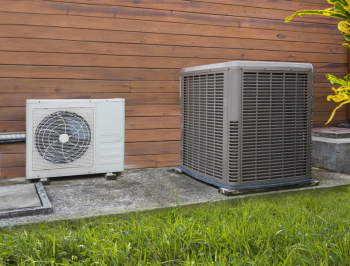

By David Lis | Fri, June 27, 25
The Northeast and Mid-Atlantic region is committed to scaling up adoption of high-performance air source heat pumps (ASHPs) in homes to address energy affordability, reduce emissions, and improve comfort and resilience. NEEP recently published a series of reports to examine the current market and provide guidance on how to further scale adoption. The series includes a new market assessment for air source heat pump equipment that includes sections on key market actors, sizing the current heating, ventilation, and air-conditioning (HVAC) equipment market, estimating current installed costs, summarizing ASHP program activity, and market development opportunities for scaling adoption. NEEP also published three best practice guides that cover midstream program implementation, workforce development, and co-promotion of ASHPs and weatherization measures.
ASHP Market Assessment
Between 2013 and 2021, ASHP sales across New England and New York grew nearly 400 percent, from roughly 50,000 to nearly 250,000! Across this timeframe, sales data was available through a market tracking program provided by the Heating Air-Conditioning Refrigeration Distributors International (HARDI) and its participating members. By 2021, this data tracking ended and left the region without a source of timely, geographically specific sales data.
To better understand ASHP sales trajectory beyond 2021, NEEP’s market assessment team used a series of available data sources to estimate sales from 2021-2023 across the broader Northeast and Mid-Atlantic regions. In recent years (2021-23), estimated ASHP sales in the Northeast climbed from approximately 408,000 to 458,000 units – a 12 percent increase. The region outperformed the national market, which saw an eight percent decline in ASHP sales during the same period (approximately 3.9 million to 3.6 million units).
Across New England and the Mid-Atlantic states, the report estimates that ASHPs represented 32 percent of the residential HVAC equipment market (which includes annual sales of ASHPs, furnaces, boilers, and central air conditioners) in 2023. But there is room for more widespread adoption. Many states in the region have committed to 65 percent market penetration by 2030 (see multi-state MOU) and some are participating in a large-scale regional program called the New England Heat Pump Accelerator.
While the NEEP research team estimated HVAC market activity, it is not a substitute for a consistent source of sales data by state. The region should work collectively to address the lack of timely HVAC sales data.
Assisting the Region to Expand Adoption with Best Practice Guides
NEEP published a series of best practice guides to address some key opportunities for wider adoption of high-performing heating and cooling equipment. These guides provide effective strategies for overcoming the most persistent barriers to adoption and address mid-stream program design and implementation, workforce development, and co-promotion of ASHPs and weatherization. Below we highlight a few of the best practices identified in the three guides.
Midstream Heat Pump Programs
Midstream programs target the middle of the supply chain, including distributors and contractors, rather than end-use consumers. While typical programs target customers to create a change in behavior, midstream programs increase the availability and promotion of high-performance HVAC products by providing training and incentives directly to distributors and contractors. Some key strategies include reducing risk for supply chain partners, paying incentives more quickly, maintaining long-term consistency in program requirements and incentives, simplifying data collection, and communicating regularly and effectively.
ASHP Workforce Development
As demand for high-performance HVAC equipment – especially for energy efficient air source heat pumps – grows in the Northeast, there is a critical need to develop a new generation of qualified installers to deliver these solutions. A few of the program best practices include having a strategic recruiting process for prospects, upskilling existing HVAC/R professionals, demystifying the licensing process, and providing wraparound support services. Partnering with ASHP industry actors like manufacturers and distributors is crucial for developing and growing the workforce.
Co-Promotion of Heat Pumps and Weatherization
An increasing number of programs cross- or co-promote heat pumps and weatherization in a more integrated way to increase uptake by leveraging initial interest in one of the two. Programs co-promote the two measures through program requirements, tiered financial incentives, and education. Some programs view the inclusion of weatherization with high efficiency heat pumps as a consumer protection strategy to maximize utility cost savings. Programs can also simplify program participation for customers by providing a single point of contact, ensure affordability by linking weatherization to heat pump programs, and provide contractor training.
Focus Areas for Expanding the Current Market
The region can leverage its existing infrastructure to grow the market even further. NEEP engaged with a wide spectrum of market actors to identify key opportunities to continue growing the regional market. These opportunities involve collaboration across a range of market actors including state and local policymakers, energy efficiency program administrators, manufacturers, distributors, and HVAC contractors. The market development opportunities are grouped into six focus areas with select strategies from the report presented below.
Promote a range of ASHP applications
- Support and deliver both whole home and partial displacement ASHP applications to take advantage of significant opportunities for growth
- Transition residential cooling equipment to centrally ducted ASHPs.
Improve the economic value proposition for ASHPs
- Target customers with high economic value propositions (existing delivered fuel/electric resistance customers, one-way air conditioner replacements)
- Reform electric rate design to improve the operational economics of heat pumps.
- Improve both upfront and operational cost transparency for customers.
- Support financing opportunities.
Drive customer demand and satisfaction
- Increase customer education through outreach and engagement strategies.
Grow and enhance the region’s workforce
- Deepen collaboration with manufacturers, distributors, educational institutions, and training providers on installer training and education.
- Emphasize quality design, sizing, and installation of ASHP systems through contractor training.
Modernize program design
- Simplify program participation and ensure safeguards for low-to-moderate income customers.
- Engage the supply chain through well-designed midstream incentives and collaborative training and marketing efforts.
- Promote partnerships and funding for inclusive local community engagement and support.
Plan effectively for complementary state policy and regulation
- Set targets aligned with the pace of needed market transition.
- Develop timely reporting structures and data availability for heat pump sales.
- Seek consistency with regional partners to ease regulatory compliance.
Doubling Down on Progress
For over a decade, NEEP’s regional heating electrification initiative has advanced the adoption of high-performing heating and cooling equipment to expand the reach of these energy-efficient technologies to a broader range of consumers in the Northeast. Although the region has achieved exciting progress in the past decade, partners must come together to meet the region’s 2030 ambitions. The ASHP market assessment report and best practice guides provide important insights into priorities for the coming years.
Join us for a Ready, Set, Scale webinar July 24 where we will present the market assessment and featured speakers will discuss how the region can double down on progress to meet goals for 2030. We’ll also share our best practice guides for mid-stream programs, workforce development, and co-promotion of weatherization with heat pump technologies.
To partner with NEEP and other regional stakeholders to drive transformation of the residential HVAC market, visit NEEP’s initiative page.


